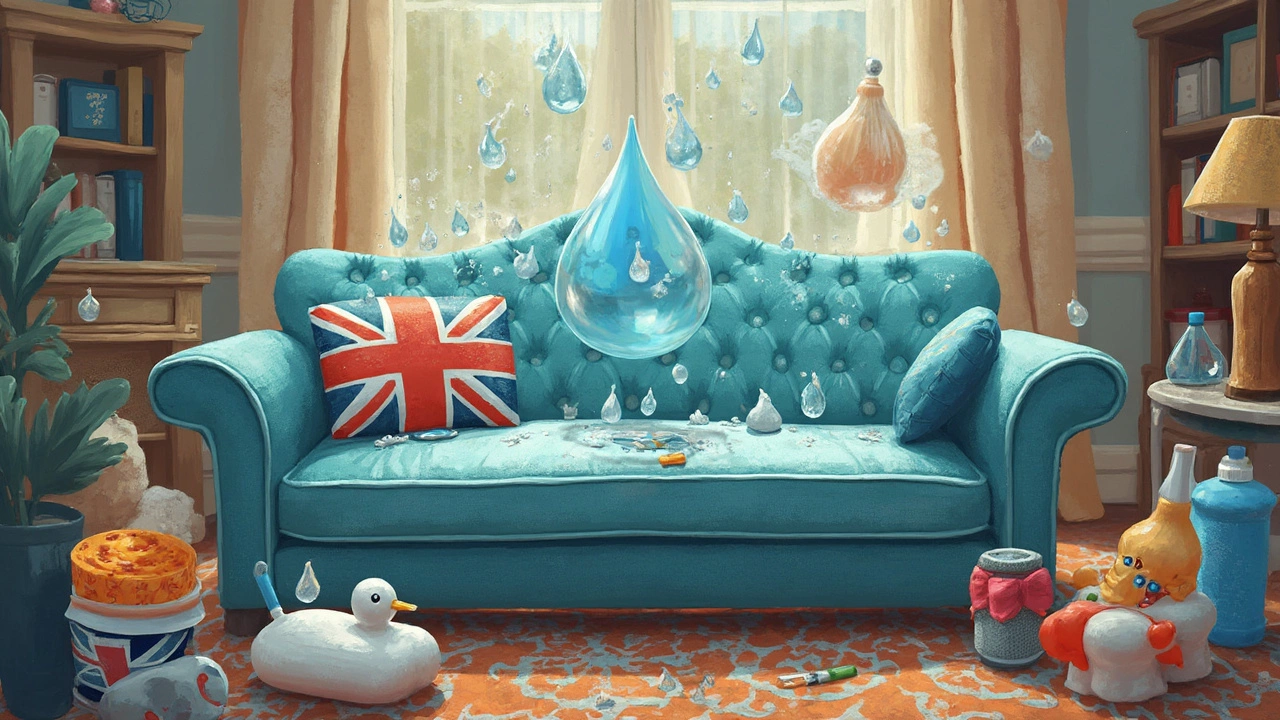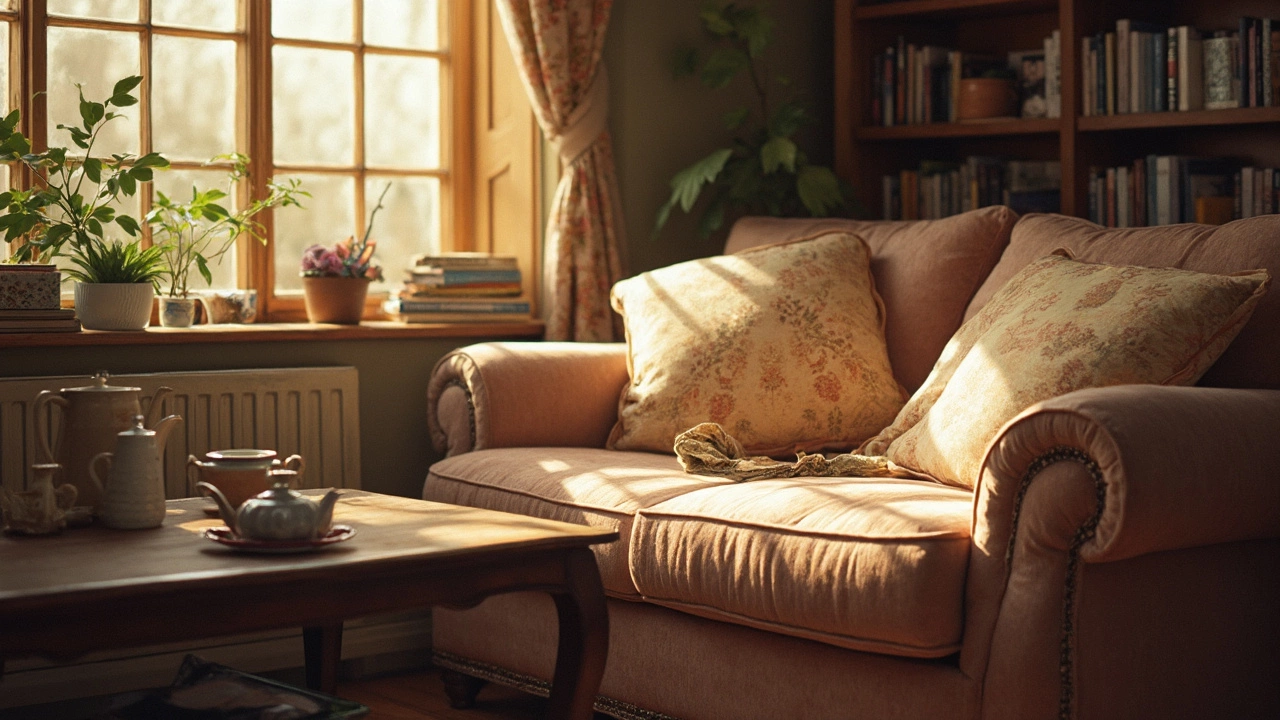Ever tried cleaning a fabric couch, only to find weird water marks marring your good work? Yeah, it's frustrating. But don't sweat it—there's a knack to getting it right, and I'm here to spill the beans.
First off, those pesky water marks often happen because the fabric dries unevenly. It sounds technical, but think of it like when you wash a t-shirt and it leaves rings because some parts dry faster than others.
The trick is in how and with what you clean. Grab a mild upholstery cleaner or a little bit of dish soap mixed with warm water. Avoid heavy soaking, just a damp cloth will do. Ditch the tap water if you can and use distilled water; it's way less likely to leave marks.
We'll get into the specifics soon, but here's a spoiler: gentle blotting, not scrubbing, is your best friend. Anyway, let's unravel the mystery of spotless couch cleaning, minus the water rings.
- Understanding Water Marks
- Essential Cleaning Tools
- Pre-Cleaning: Preparing Your Couch
- Spot Cleaning Techniques
- Drying Without Water Marks
- Maintenance Tips for a Pristine Couch
Understanding Water Marks
Alright, so let's talk about one of the most annoying things when it comes to cleaning fabric couches—those dreaded water marks. Ever wondered why just wiping a spill sometimes leaves a mark that's worse than the original stain? It's all about how water and fabric interact.
When you clean with water, especially tap water, minerals and impurities can be left behind as the water evaporates. This results in those circular stains we despise. And it's not just about the quality of water. It's how the fabric dries. If areas dry at different rates, you might end up with rings where the water evaporated last.
"Water marks often arise from uneven drying and mineral residues," explains upholstery expert Jane Barrett from the National Upholstery Association.
Some fabrics are more prone to showing these marks than others. Materials like suede and some cotton blends may highlight these imperfections more. Knowing the type of fabric you have is half the battle.
To avoid these marks, using distilled water is key since it lacks minerals that cause spots. It’s also crucial to ensure even drying. This might mean carefully blotting out excess moisture and avoiding direct heat like hair dryers, which can worsen the marks by drying some areas faster than others.
| Common Causes of Water Marks | Solutions |
|---|---|
| Mineral deposits in tap water | Use distilled water |
| Uneven drying | Ensure consistent moisture removal across the fabric |
So, there you have it—some insider info on why those water marks show up. Knowing this can turn couch-cleaning from a dreaded chore into something you can handle with confidence, leaving your fabric couch looking pristine without any unwanted rings.
Essential Cleaning Tools
So, you've decided to tackle your fabric couch cleaning mission head-on. Smart move! But before diving in, let's talk tools. Having the right gear can make the difference between a sparkling sofa and a soggy mess.
First thing, snag yourself a vacuum cleaner with an upholstery attachment. It's perfect for sucking up all those crumbs and pet hairs that like to hide in the nooks and crannies. Give your couch the once-over before any cleaning solution touches it. Trust me, it makes life easier.
Next on the list is a set of clean, white microfiber cloths. Opt for white so there’s no risk of color transfer. Microfiber is soft but tough on stains, though, which is ideal for our mission here. If you don’t have microfiber, a plain old white cotton cloth works too.
Speaking of solutions, a mild upholstery cleaner or a simple mix of dish soap and warm distilled water does wonders. You can find specialty cleaners at most supermarkets, but homemade brews are also effective and wallet-friendly.
- Upholstery Cleaner: Ensure it's safe for your fabric type.
- Dish Soap: Just a couple of drops, mixed well with water.
- Distilled Water: Reduces chances of residues or marks.
Don't forget a soft-bristled brush. It helps in gently lifting away dirt and grime, especially in those tricky spots.
A fan or a hair dryer set to cool can be a game-changer for drying without leaving those dreaded water marks. Just make sure to keep the airflow moving so no part gets too wet.
And finally, a protection spray can be your couch's best friend. Applied after cleaning, it helps ward off future spills and stains. Imagine it like a superhero cape for your couch.
Pre-Cleaning: Preparing Your Couch
Alright, before you dive into cleaning your fabric couch, let's get prepped for an easy ride. You can't just splash on some soap and hope for the best. First things first, give your couch a good once-over and remove any loose cushions. This lets you see what you're working with and spot any forgotten crumbs or small toys hiding in the corners.
Next, grab your vacuum cleaner. Attach the upholstery brush and give the entire couch a thorough vacuum. Focus on seams and folds where dirt likes to hide. This isn’t just about hygiene—vacuuming helps lift dry particles that might scratch or damage the fabric during cleaning.
Now, tackle those pesky lint balls and hair with a lint roller or a piece of sticky tape. Trust me, even the cleanest homes have their share of these.
Got any stains you’re worried about? Spot check those little troublemakers with a wet cloth to see if they’re water-soluble. If not, you might need something stronger than water. Just make sure to test your chosen cleaner on a hidden bit of the material to avoid unwelcome surprises.
Finally, check the cleaning tag. Most fabrics have labels like W (water-based cleaner), S (solvent-based cleaner), WS (water or solvent-based cleaner), or X (vacuum only). This tiny tag is the holy grail of sofa care, telling you what works best without risking damage.
With the couch ready, you’re all set to clean without leaving water marks. Here’s to a hassle-free and effective cleaning session!

Spot Cleaning Techniques
Tackling stains on your fabric couch without leaving water marks can seem like a real chore, but if you know the right spot cleaning tricks, it's not so bad. Let’s get into it.
First things first: you want to act fast. The quicker you deal with a stain, the easier it is to remove. Here’s a quick rundown of what to do:
- Blot, Don't Rub: As soon as the spill happens, gently blot the area with a clean, absorbent cloth. Rubbing pushes the stain deeper into the fabric and can widen the stain's area.
- Test Your Cleaner: Whether you’re using a store-bought upholstery cleaner or something homemade (like a mix of dish soap and distilled water), test it on a hidden corner of the couch first to make sure it doesn’t damage or discolor the fabric.
- Apply Cleaner Sparingly: Dab your cleaner lightly onto the stain with a clean cloth. The goal is to moisten the fabric just enough to lift the dirt without soaking it—remember, less water means fewer water marks.
- Blot Again: Use a dry cloth to blot the area again, pulling up as much of the moisture—and the stain—as you can.
For stubborn stains, like red wine or coffee, mixing vinegar with water can help. Just be sparing with it to avoid unnecessary soaking.
Need a quick cheat sheet? Here's a simple guide:
- Grease Stains: Sprinkle baking soda on the stain, let it sit to absorb the grease, then vacuum it up.
- Ink Stains: Dab a bit of rubbing alcohol on a cloth (use them sparingly), and gently blot the stain.
- Blood Stains: Use cold water (never hot!) and a bit of dish soap, then follow the usual blotting steps.
These spot cleaning techniques should keep your upholstery looking fresh and tidy, without those annoying water marks. Remember, gentle handling and a bit of patience are your best friends here.
Drying Without Water Marks
Okay, so you've done the hard work of cleaning your fabric couch and now it's all about nailing the drying part. This step is crucial because it's where things can go sideways if you're not careful.
When it comes to drying your couch, patience is key. Avoid the temptation to speed things up with a hairdryer on max heat. That's a big no-no, as uneven heat can cause those dreaded water marks. Instead, use a fan to blow air across the surface. This promotes even drying and helps keep the fabric in top-notch condition.
If you're dealing with a small area, paper towels or microfiber cloths can help soak up excess moisture. Just remember to change them out frequently to prevent damp spots.
An easy method to ensure everything dries evenly? Cover the damp area with a clean, dry towel and apply light, even pressure. This helps absorb moisture without pressing in water marks.
And if you want an extra tip (who doesn't?), next time you clean, grab some distilled water rather than tap water. This little switch helps reduce the minerals that often cause those sneaky marks.
- Set your fan to a gentle setting and position it about a foot away from the couch. Let it run until the fabric feels dry to the touch.
- Use a dry, clean towel to periodically press over wet spots, swapping it for a new towel when it feels damp.
- Keep windows open for good air flow, which helps speed up the drying process naturally.
Slowing it down a bit really makes a difference and ensures your couch is both clean and mark-free.
Maintenance Tips for a Pristine Couch
Keeping your fabric couch looking sharp isn't some secret art. It just takes a bit of regular TLC. Let's break down some straightforward tips to help you maintain that sofa sparkle.
1. Regular Vacuuming
Dust and dirt buildup is a sneaky culprit that can dull your couch. Once a week, whip out your vacuum cleaner—preferably with an upholstery attachment—and give it a good clean. Make sure to hit those nooks and crannies where crumbs like to hide.
2. Rotate and Flip Cushions
Over time, cushions can start sagging or becoming lopsided from daily use. Rotating and flipping them every few weeks helps distribute wear evenly, keeping them in top shape. Plus, it’s a neat excuse to check if spare change or the TV remote is lost somewhere in the depths!
3. Use Fabric Protector
Before things get messy, consider using a fabric protector. It acts like a shield against accidental spills and everyday grime. Just make sure you choose one that matches your upholstery type.
4. Address Stains Immediately
Those spills become stains if left too long. So, if something happens (and let's face it, it probably will), tackle it right away. Blot with a clean, damp cloth and a tiny bit of upholstery cleaner. Remember, blot don't scrub!
5. Avoid Sun Exposure
If your couch is basking in the sun every day, the fabric might fade over time. Try to position the couch away from direct sunlight or use blinds during the brighter parts of the day.
Following these easy steps can extend the life of your beloved couch and keep it looking like the day you got it. Treat it right, and it will be there for all your naps, movie marathons, and lazy Sunday mornings!
